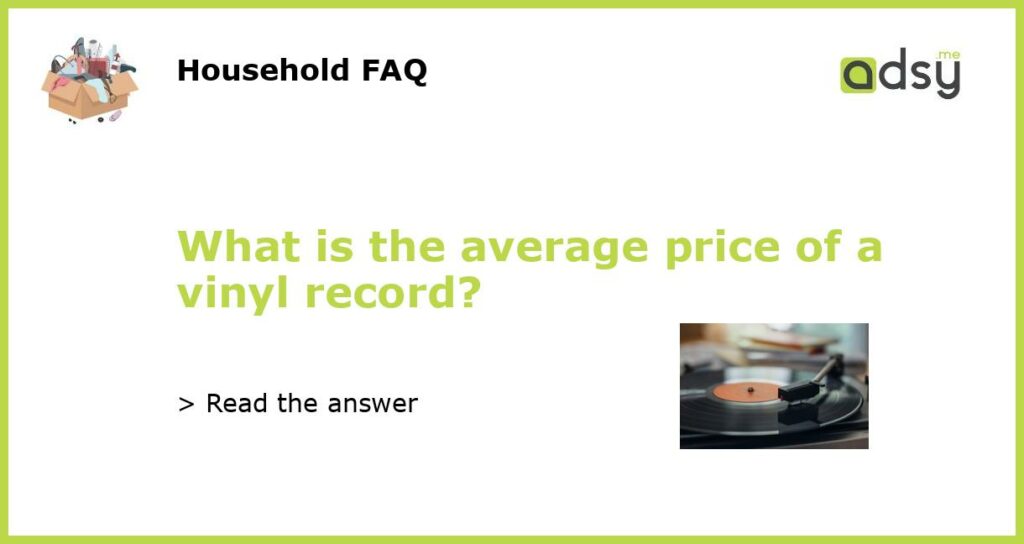The Average Price of a Vinyl Record: Exploring the Factors That Determine Cost
If you’re a music enthusiast or collector, you may be curious about the average price of a vinyl record. Vinyl records have experienced a resurgence in popularity over the past few years, with many music lovers appreciating their unique sound and tangible nature. However, there isn’t a one-size-fits-all answer to this question, as the price of a vinyl record can vary greatly depending on several factors. In this article, we’ll explore the key factors that determine the cost of a vinyl record and provide you with a comprehensive understanding of the average price range.
The Demand and Rarity of the Record
One of the primary factors that influences the price of a vinyl record is its demand and rarity. If a record is highly sought after by collectors and has a limited supply, its price can skyrocket. This is especially true for records that are considered to be iconic or have historical significance in the music industry. For example, a rare first pressing of The Beatles’ “White Album” or an original copy of Elvis Presley’s debut album can fetch a hefty sum in the collector’s market. The scarcity and desirability of the record significantly impact its price.
Condition and Quality of the Record
The condition and quality of a vinyl record also play a crucial role in determining its price. A record that is in excellent condition, with no scratches, warps, or other defects, will have a higher value than one with visible signs of wear and tear. Collectors and enthusiasts pay a premium for records that have been well-maintained and preserved over time. Additionally, the quality of the audio recording itself can affect the price. Records that were produced using high-quality materials and mastered with care often command higher prices due to their superior sound reproduction.
Artistic Value and Packaging
In addition to the music itself, the artistic value and packaging of a vinyl record can also contribute to its price. Limited edition releases, picture discs, colored vinyl, and records with unique cover art or inserts are often priced higher than standard releases. The visual appeal and collectability of these records attract buyers who are willing to pay extra for a unique addition to their collection. Additionally, special editions released by popular artists or bands, such as box sets or signed copies, can command premium prices due to their exclusivity.
Genre and Historical Significance
The genre of music and the historical significance of a vinyl record can also affect its price. Some genres, such as jazz, blues, and punk, have a dedicated fan base that values vinyl records as a tangible connection to the music’s roots and history. Records from iconic artists or albums that have had a significant impact on the music industry are often considered valuable collectibles. For example, a vinyl record from a groundbreaking album like Pink Floyd’s “The Dark Side of the Moon” or Bob Dylan’s “Highway 61 Revisited” may have a higher price tag due to their cultural and historical importance.
Market Demand and Seller’s Pricing
Lastly, the average price of a vinyl record is also influenced by market demand and the pricing strategies of sellers. In the collector’s market, the law of supply and demand applies. If a particular record becomes highly sought after, its price can increase as sellers try to capitalize on the increased demand. On the other hand, if a record doesn’t generate much interest or has a large supply, its price may be lower. Additionally, factors such as the reputation and pricing policies of record stores, online marketplaces, and individual sellers can also impact the average price of a vinyl record.


![Hans Zimmer - The Classics. 2LP Limited Edition [VINYL]](https://m.media-amazon.com/images/I/515ic+3zkvL.jpg)
![Gold [VINYL]](https://m.media-amazon.com/images/I/412V5CqjjnL.jpg)
![All Over The World: The Very Best Of Electric Light Orchestra [VINYL]](https://m.media-amazon.com/images/I/61oLgTtzb9L.jpg)
![Legend [VINYL]](https://m.media-amazon.com/images/I/51f87rHQ-bL.jpg)
![Rumours [VINYL]](https://m.media-amazon.com/images/I/41jOOB2R17L.jpg)